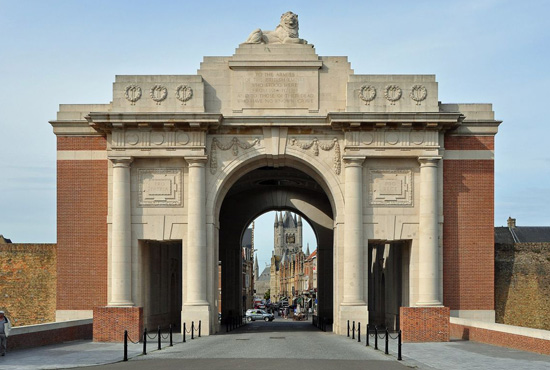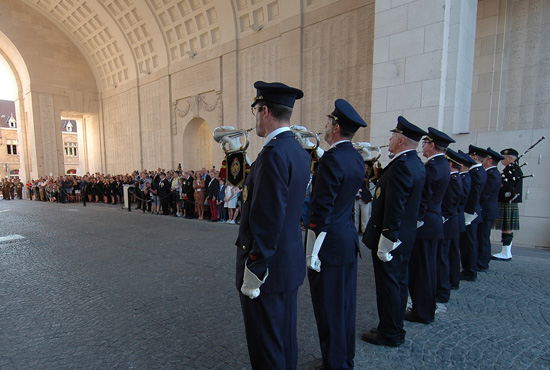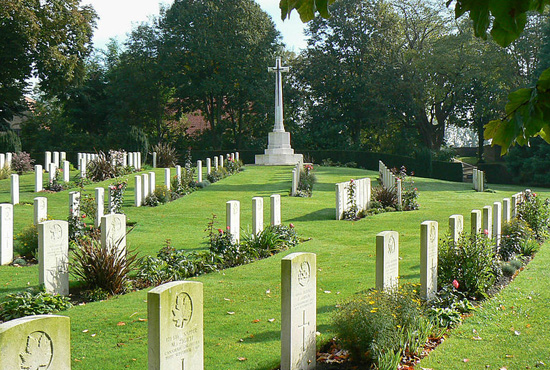Menin Gate
Memorial
The Menin Gate Memorial to the Missing is a war memorial in Ypres, Belgium dedicated to the British and Commonwealth soldiers who were killed in the Ypres Salient of World War I and whose graves are unknown.
Discover
The Menin Gate Memorial to the Missing is a war memorial in Ypres, Belgium dedicated to the British and Commonwealth soldiers who were killed in the Ypres Salient of World War I and whose graves are unknown.
Discover
Following the Menin Gate Memorial opening in 1927, the citizens of Ypres wanted to express their gratitude towards those who had given their lives for Belgium's freedom. As such, every evening at 20:00, buglers from the local fire brigade close the road which passes under the memorial and sound the "Last Post".
Discover
The small and intimate Ramparts Cemetery on the Ypres city walls near the Lille Gate and the larger Ypres Reservoir Cemetery.
DiscoverMuseums
The renovated In Flanders Fields Museum faces the visitor with the consequences of the Great War. It confronts young and old with life and death in the Ypres front region...
>> WebsiteThis museum is housed in a restored chapel located where one of the fiercest battles of Ypres was fought and right opposite the ?Hooge Crater Cemetery'. The private museum is highly recommended because of its life-sizes reconstructions of war scenes, is extensive collection of weapons, equipment and photos. You can also enjoy an impressive ?trench art' collection in the cafeteria...
>> WebsiteUsing vivid dioramas, soil finds and a unique reconstruction of an underground shelter 6m in depth from 1917, the museum tells the story of the Battle of Passendale also known as the third battle of Ypres...
>> WebsitePoperinge was situated about 10 miles behind the front lines of the Ypres Salient, right in the middle of the British sector. During the first world war there were about 250,000 British soldiers in and around Poperinge although it had only had 20,000 inhabitants in peace time...
>> Website"I fell totally in love with the spicy humour of this museum. This is one of the most interactive and family-friendly museums I've visited so far. No matter the age: everyone can create their own unique visitor experience. Furthermore, it's great to remember that places torn apart by war have a story before the destruction that should not be forgotten. Now we see this place with new eyes, thanks to the Yper Museum."
>> WebsiteThis mansion is a perfect reconstruction of the building from 1174. In beautifully decorated salons and boudoirs you will see original French period furniture, paintings and silverware, saved from the fires of the First World War. There is also a unique collection of Chinese and Japanese porcelain. The guide talks about the fortunes of the Merghelynck family in a beautiful and fun way. The outsider among the Ypres museums!
>> WebsiteSights & WW1 Sites
One of the best known world war 1 sites in the Ypres salient is Essex Farm Cemetery and Advanced Dressing Station where John McCrae wrote his famous poem In Flanders Fields at the beginning of May 1915...
The Cloth Hall served as a covered sales and storage place for cloth on the (now vaulted) waterway called the Ieperlee. The construction of the Cloth Hall was completed in 1304. In this building the cloth underwent its last official control, after which the cloth salesmen could stock and sell...
The name Passendale is indelibly etched on the collective consciousness of Great-Britain and her Commonwealth. During the Third Battle of Ieper (1917) the British Army lost nearly 300.000 men to capture this ruined village ?Passion Dale' - the valley of suffering. The cost in human life to achieve this 'victory' is all too evident in Tyne Cot Cemetery, the largest British war cemetery on mainland Europe...
This hill was created by the earth excavated from the adjacent railway cutting. In 1914 it was captured by the Germans from the French. Later, this sector was taken over by the British, who began an underground war of mines and counter-mines. It is near the other famous Great War site, Hill 62.
This Anglican church was built in 1928-1929 following the plans of London architect Sir Reginald Blomfield. This ?Memorial church' holds many reminders of the First World War. Everything down to the furniture was donated by British associations, regiments or individuals...